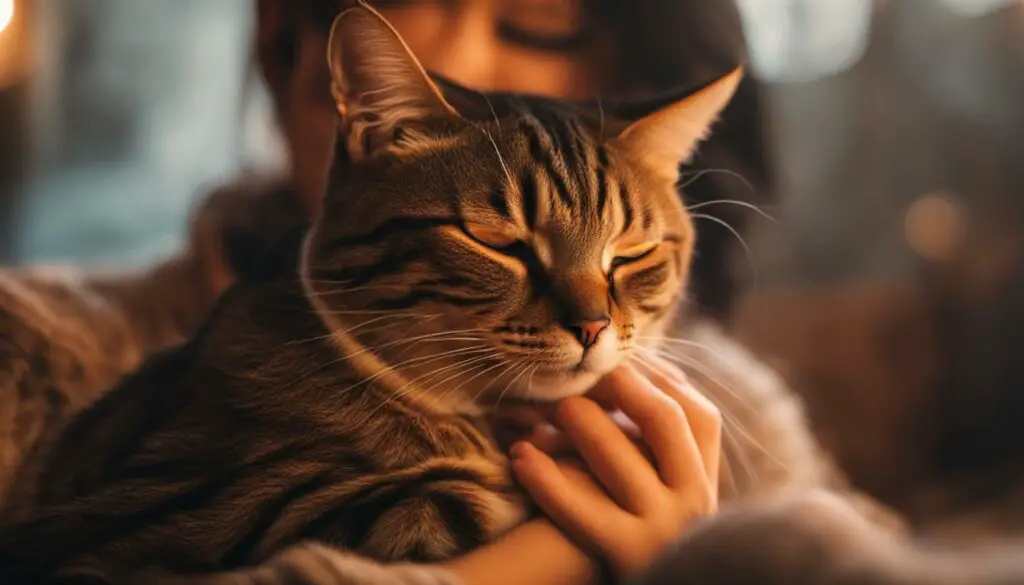Have you ever wondered what it means when your cat headbutts you? Cat headbutting behavior can sometimes be confusing, but it’s actually a form of communication and affection that cats use to express their feelings towards you. In this article, I will explain the different meanings behind cat headbutting and why it’s important to understand this behavior.
Key Takeaways:
- When a cat headbutts you, it can be a sign of affection and love.
- Headbutting is also a way for cats to mark their territory and establish familiarity.
- Cat headbutting is a behavior that strengthens the bond between cats and their owners.
- Excessive headbutting or unusual behavior may indicate underlying health issues.
- Observing your cat’s headbutting style can help you understand their individual communication preferences.
The Affectionate Gesture of Cat Headbutting
In the world of feline communication, headbutting is often seen as an affectionate gesture. When your cat gently bumps their head against you, it’s their way of expressing love and attachment. This seemingly simple action holds profound meaning and can deepen the bond between you and your furry friend.
By interpreting your cat’s headbutts, you can gain valuable insights into their behavior. They are using this gesture to communicate their affection, trust, and comfort towards you. It’s their way of saying, “You are important to me, and I feel safe with you.”
When a cat headbutts you, the physical contact also allows them to mark you with their scent, which further strengthens their sense of ownership and territorial claim. Cats have scent glands located on their cheeks, lips, and forehead, and by rubbing against you, they are leaving their mark, signaling that you are a cherished part of their territory.
To better understand your cat’s headbutting behavior, pay attention to the context in which it occurs. Observe their body language, vocalizations, and any accompanying behaviors. These subtle cues can provide additional insights into their intentions and emotional state. Remember, each cat is unique, so take the time to learn your cat’s individual communication style and preferences.

Table: Decoding Cat Headbutting
| Behavior | Meaning |
|---|---|
| Light headbutt with purring | An affectionate greeting or seeking attention |
| Repeated headbutts | Expressing deep affection and trust |
| Headbutting with kneading | Feeling content, relaxed, and secure |
| Forceful headbutt with growling | Signs of aggression or discomfort |
Understanding the nuanced meanings behind your cat’s headbutting behavior can help strengthen the bond between you and your feline companion. Embrace their affectionate gestures, reciprocate their love, and enjoy the unique form of communication that exists between you.
Marking Territory Through Headbutting
When cats headbutt, they are not only expressing affection but also marking their territory. Cats have scent glands located in their cheeks, lips, and forehead. By rubbing their heads against you, they are leaving their scent behind and claiming you as part of their territory. This behavior helps create a sense of familiarity and ownership.
Understanding the significance of marking territory through headbutting is essential in interpreting your cat’s behavior. It shows that your cat feels comfortable and secure in your presence and considers you a trusted companion. By allowing them to mark you with their scent, you are reinforcing the bond between you and your feline friend.
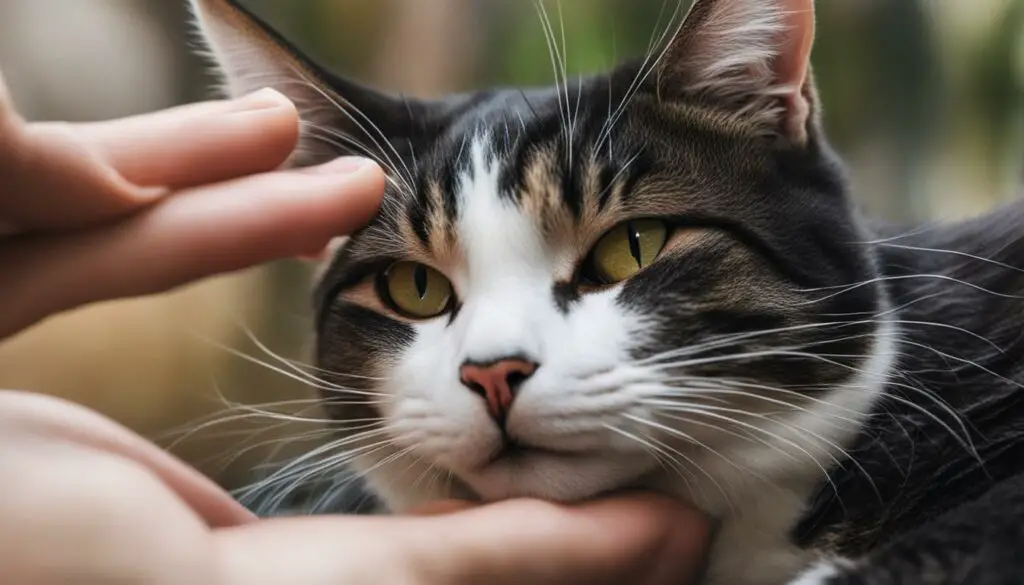
Marking Territory: A Natural Instinct
Marking territory through headbutting is a natural instinct for cats. In the wild, cats use scent marking to communicate with other felines and establish their territory. By marking you, they are sending a message to other animals that you are part of their personal space.
It’s important to note that marking territory through headbutting is not a sign of aggression. Instead, it is a way for cats to create a sense of security and establish their presence in their surroundings. By understanding this behavior, you can better decode your cat’s communication signals and deepen your bond with them.
| Significance of Marking Territory Through Headbutting | Explanation |
|---|---|
| Claims ownership | By marking you with their scent, cats are asserting ownership over you and their immediate surroundings. |
| Creates familiarity | The scent left behind through headbutting helps create a familiar environment that makes your cat feel safe and secure. |
| Strengthens bond | Allowing your cat to mark you with their scent reinforces the bond between you and builds trust. |
By understanding the significance of marking territory through headbutting, you can appreciate this behavior as a positive expression of your cat’s love and trust in you.
Trust and Comfort in Cat Headbutts
When your cat headbutts you, it’s not just a random behavior. It’s a sign of trust and comfort. Cats are selective in whom they headbutt, reserving this gesture for those they feel safe and secure with. So, if your furry friend leans their head against you, take it as a compliment!
Headbutting is a way for cats to establish a closer bond and communicate their affection. It’s their way of saying, “I trust you, and I feel safe in your presence.” By reciprocating their headbutt with a gentle lean or a soft touch, you reinforce that bond and deepen your connection with your feline companion.
Next time your cat headbutts you, remember that it’s a positive and loving gesture. Embrace it as a sign of the trust and comfort your cat has in your relationship. Cherish these precious moments of affection, as they are a testament to the strong bond you share.
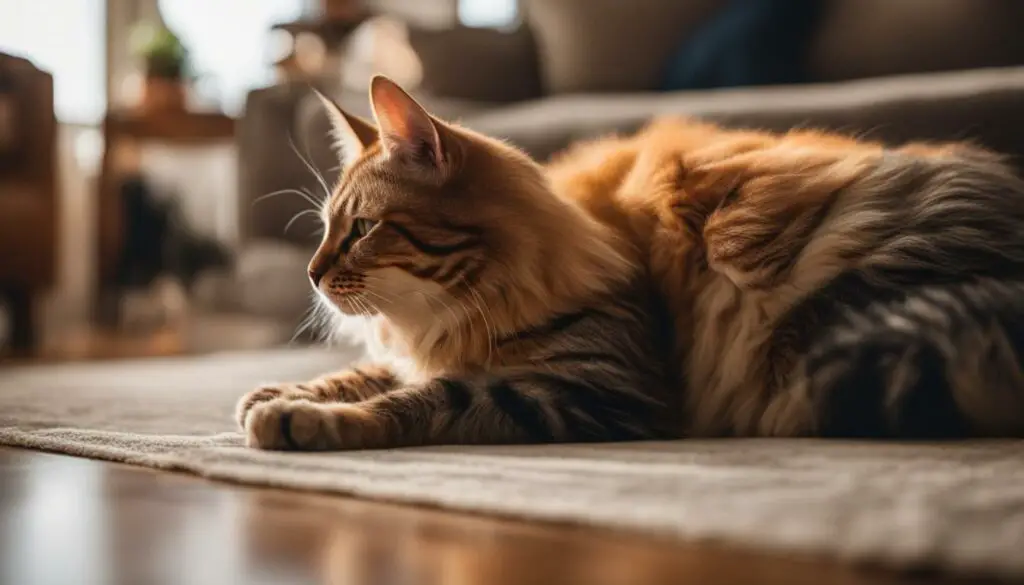
| Trust and Comfort in Cat Headbutts | Why does my cat headbutt me? | Cat Headbutt Affection | Interpreting Cat Headbutts |
|---|---|---|---|
| Headbutting is a sign of trust and comfort in cats. | Cats headbutt to express their trust in their owners. | Headbutting is a gesture of affection from cats. | Understanding cat headbutts can help strengthen the bond between cats and their owners. |
| Cats only headbutt people or animals they feel safe and comfortable with. | Headbutting is a way for cats to communicate their comfort and security. | By reciprocating their headbutt, owners can reinforce the bond with their cats. | Observing a cat’s headbutting behavior can provide insights into their feelings and emotions. |
| Headbutting is a positive and loving gesture. | Headbutting is a way for cats to show their trust and affection. | Embracing a cat’s headbutt can strengthen the relationship between cat and owner. | Understanding cat headbutts can deepen the connection between cat and owner. |
Multiple Meanings of Cat Headbutting
Cat headbutting is a fascinating behavior that can have multiple meanings depending on the context. While it is often seen as an affectionate gesture, there are other explanations for why cats engage in headbutting. Understanding these various meanings can help us better interpret our feline friends’ communication signals.
One possible interpretation of cat headbutting is that it serves as a form of dominance. When a cat headbutts another cat or even a human, it can be a way for them to assert their authority and establish their place in the hierarchy. Pay attention to the accompanying behaviors, such as body posture and tail movements, to better understand if the headbutt is a display of dominance.
Another meaning behind cat headbutting is the desire to mark territory. Cats have scent glands located in their cheeks, lips, and forehead. When they headbutt an object or a person, they are essentially claiming it as part of their territory. This behavior helps create a sense of familiarity and ownership, making the cat feel more secure in their environment.
“Understanding the specific context and accompanying behaviors can help interpret the meaning behind each headbutt.”
Cat headbutting can also be a way for cats to seek attention. By gently tapping their heads against us, they are communicating their desire for interaction and companionship. It’s important to pay attention to our cats’ headbutts and respond to their needs, whether it’s providing them with playtime, cuddles, or addressing any potential issues they may have.
While cat headbutting is generally a positive behavior, it’s essential to note that excessive or forceful headbutting, along with signs of discomfort or pain, may indicate underlying health concerns. If you notice any unusual behaviors or have concerns about your cat’s headbutting, it’s always a good idea to consult with a veterinarian.
| Meaning | Behavior |
|---|---|
| Affection | Gentle headbutt accompanied by purring and kneading |
| Dominance | Firm headbutt with assertive body language |
| Territory marking | Repeated headbutting against objects or people |
| Attention-seeking | Headbutting followed by meowing or rubbing against the person |
Attention-Seeking Behavior
One of the possible reasons why cats headbutt their owners is to seek attention.
When a cat taps their head against you, it’s their way of communicating that they want your company or that they have a need, such as an empty water bowl or a desire to play. By paying attention to their headbutts, you can better understand their needs and provide appropriate care.
If you notice your cat headbutting you and displaying other attention-seeking behaviors, such as meowing or rubbing against your legs, it’s important to respond to their needs. Spending quality time with your cat, playing interactive games, or simply offering them affectionate attention can help fulfill their social and emotional needs.
“When a cat headbutts me, I take it as a sign that they want some extra love and attention. I make sure to give them the time and affection they’re seeking, and it always strengthens our bond.”
Remember, cats are social creatures and rely on positive interactions with their owners for their overall well-being. By understanding and responding to their attention-seeking behavior, you can foster a deeper connection with your feline companion.
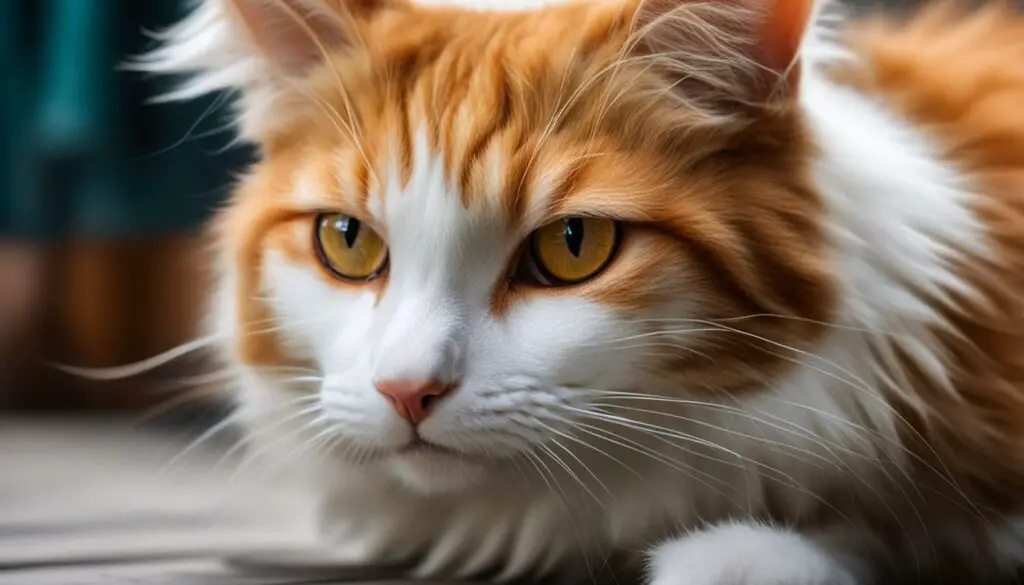
| Signs of Attention-Seeking Behavior | Ways to Address the Behavior |
|---|---|
| – Headbutting | – Spend quality time with your cat |
| – Meowing | – Play interactive games |
| – Rubbing against your legs | – Offer affectionate attention |
Excessive Headbutting and Health Concerns
While headbutting is generally a normal behavior, excessive headbutting accompanied by other concerning behaviors may indicate underlying health issues. If you notice your cat headbutting excessively or displaying other unusual behaviors, it’s essential to consult a veterinarian to rule out any health concerns.
Cats use headbutting as a form of communication, but when it becomes excessive, it could be a sign that something is wrong. Excessive headbutting, especially when combined with aggression, lethargy, or changes in appetite, can indicate pain or discomfort. It could be a sign of dental problems, ear infections, or even neurological issues. Consulting a veterinarian is crucial to identify and address any underlying health issues.
In addition to excessive headbutting, other concerning behaviors to watch out for include excessive grooming, hiding, changes in litter box habits, and loss of appetite. These behaviors may indicate stress, anxiety, or medical conditions that require professional attention.
Signs of Discomfort or Pain
If your cat displays signs of discomfort or pain while headbutting, it’s important to take it seriously. Keep an eye out for these signs:
- Flattened ears
- Dilated pupils
- Growling or hissing
- Withdrawal or aggression
- Limping or difficulty moving
These signs may indicate an underlying health condition that needs to be addressed promptly. Remember, cats are masters at hiding pain, so any unusual behavior should be taken seriously.
| Signs of Discomfort or Pain in Cats |
|---|
| Flattened ears |
| Dilated pupils |
| Growling or hissing |
| Withdrawal or aggression |
| Limping or difficulty moving |
Reciprocating Cat Headbutts
When your cat affectionately headbutts you, it’s a heartwarming gesture that showcases their love and trust. You can further strengthen your bond by reciprocating this behavior and engaging in a gentle headbutt with your feline friend. By doing so, you reinforce their trust in you and communicate your affection in a way that they understand.
To reciprocate your cat’s headbutt, simply lean in and allow your cat to nudge their head against yours. This gentle interaction not only deepens your emotional connection but also provides a physical form of reassurance for your cat. It’s important to remember to be gentle and not force the headbutt if your cat seems hesitant or uncomfortable.
By reciprocating your cat’s headbutts, you create a positive and meaningful exchange that strengthens the bond between you. This simple act of trust and affection can go a long way in nurturing a loving relationship with your feline companion.
 |
Reciprocating Cat Headbutts |
|---|
Environmental Factors Influencing Headbutting Behavior
When it comes to cat behavior, headbutting is a fascinating and intricate form of communication. It can convey affection, mark territory, seek attention, and more. However, the frequency and intensity of headbutting can be influenced by various environmental factors.
Firstly, the presence of other animals in the household can impact a cat’s headbutting behavior. Cats may headbutt more frequently if they feel the need to establish their dominance or communicate their social status. On the other hand, the presence of new or unfamiliar animals may cause some cats to headbutt less or even avoid it altogether.
Changes in the household routine or environment can also affect a cat’s headbutting behavior. These might include moving to a new home, rearranging furniture, or introducing new people into the household. Cats are territorial creatures, and any disruptions to their established environment can cause stress and potentially alter their headbutting patterns.
Furthermore, the availability of resources, such as food, water, and comfortable resting spots, can impact a cat’s desire to headbutt. If a cat is feeling uncertain or insecure about their resources, they may be less inclined to engage in headbutting behavior.
| Environmental Factors | Influence on Headbutting Behavior |
|---|---|
| Presence of other animals | Can increase or decrease headbutting frequency |
| Changes in the household routine or environment | May cause changes in headbutting patterns |
| Availability of resources | Can impact a cat’s desire to engage in headbutting |
Understanding the environmental factors that influence headbutting behavior can help cat owners interpret their feline companions’ communication signals more accurately. By creating a stable and comfortable environment, cat owners can encourage positive headbutting interactions and strengthen their bond with their cats.
Unique Headbutting Styles Among Cats
Each cat has its own unique style of headbutting, showcasing their individuality and communication preferences. Some cats may lightly tap their heads against you, while others may rub their entire face on your legs or hands. By observing your cat’s headbutting style, you can gain a deeper understanding of their personality and the messages they are trying to convey.
For example, a gentle head tap may indicate a cat’s desire for attention or simply a way to say hello. On the other hand, a cat that vigorously rubs its face against you may be seeking more intense interaction or displaying dominance. By paying attention to the nuances of your cat’s headbutting behavior, you can respond in a way that aligns with their specific communication style.
It’s important to note that while headbutting styles may vary, the underlying meaning remains consistent. Regardless of how your cat chooses to express themselves through headbutting, it is a gesture of love, trust, and connection. Embrace and appreciate their unique style, and reciprocate with gentle affection to strengthen your bond.
Cat Headbutting Among Multiple Cats
When it comes to cat headbutting, it’s not just a behavior reserved for humans. Cats may also engage in headbutting with each other as a way to establish a communal scent and strengthen their bond. By observing their headbutting interactions, you can gain valuable insights into their social dynamics and relationships.
Headbutting between cats is a non-confrontational behavior that often occurs during friendly encounters. It serves as a way for cats to exchange scents and communicate their acceptance and affiliation with one another. Through headbutting, cats establish a shared scent profile, which helps create a sense of unity and belonging within their social group.
It’s important to note that not all cats will exhibit headbutting behavior towards each other. Some cats may not be as inclined to engage in this behavior, while others may headbutt more frequently. Factors such as the cats’ personalities, hierarchy within the group, and their level of comfort with each other can influence the frequency and intensity of headbutting interactions.
| Benefits of headbutting among multiple cats |
|---|
| 1. Strengthening social bonds |
| 2. Establishing hierarchy within the group |
| 3. Creating a sense of unity and belonging |
| 4. Exchanging scents and communication signals |
| 5. Facilitating cooperative behaviors and reduced aggression |
Observing the headbutting interactions among multiple cats can provide valuable insights into their relationships and dynamics. It can help you understand how they communicate and interact with each other, allowing you to foster a harmonious environment for your feline companions.
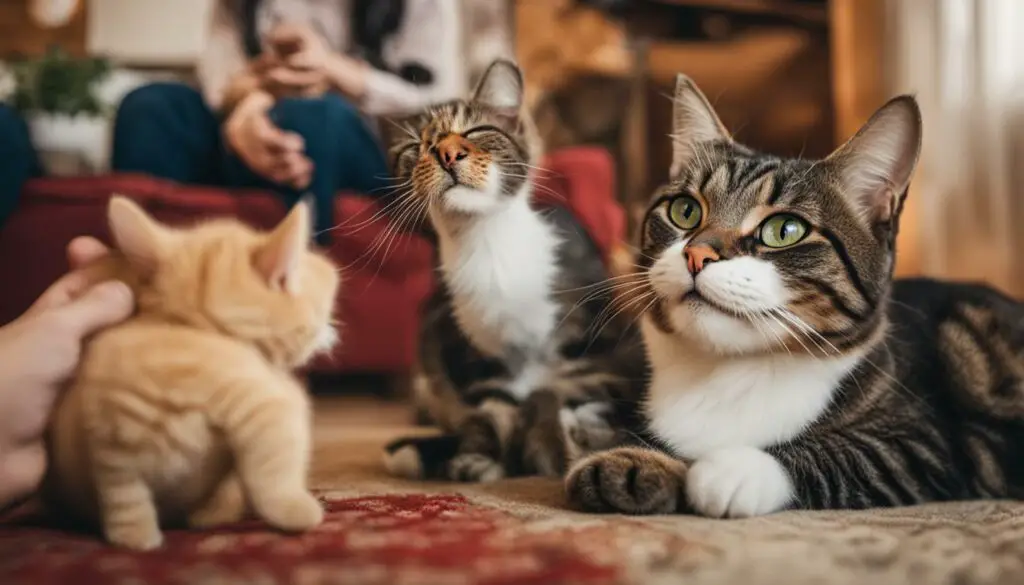
Sources:
Feline Behavior: A Guide for Veterinarians by Bonnie V. Beaver
Introducing Headbutting as a Positive Interaction
When it comes to cat behavior, headbutting is often seen as a sign of affection and trust. But what do you do if your cat is not accustomed to headbutting or seems hesitant to engage in this behavior? Introducing headbutting as a positive interaction can help your cat feel more comfortable and deepen your bond.
One way to introduce headbutting is by offering your head for them to gently bump against. Start by sitting or kneeling down to their level, and extend your head towards them. Allow them to make the first move and initiate the headbutt. If they respond positively, praise them and give them a treat to reinforce the positive association with headbutting.
It’s important to be patient and go at your cat’s pace. Some cats may take time to warm up to the idea of headbutting, while others may need more encouragement. Remember to always use positive reinforcement techniques and never force your cat to engage in headbutting if they are uncomfortable.
Creating a Positive Experience
In addition to offering your head, you can also create a positive environment for headbutting. Make sure you are in a calm and quiet space where your cat feels safe. Avoid any distractions or loud noises that may startle or stress them out. By creating a positive and relaxing atmosphere, you are more likely to have a successful headbutting session.
| Steps for Introducing Headbutting |
|---|
| Choose a quiet and comfortable environment |
| Get down to your cat’s level |
| Extend your head towards them |
| Allow them to initiate the headbutt |
| Provide positive reinforcement and rewards |
| Be patient and go at your cat’s pace |
Remember, not all cats will be headbutters, and that’s okay. Each cat has their own unique personality and preferences. If your cat doesn’t take to headbutting, try to find other ways to bond and interact with them. Whether it’s through playtime, grooming, or simply spending quality time together, there are plenty of ways to strengthen your relationship with your feline companion.
By introducing headbutting as a positive interaction, you can create a special bond with your cat and enhance your communication with them. Take it slow, be patient, and always respect your cat’s boundaries. Before you know it, headbutting may become a cherished way for you and your cat to express love and affection towards each other.

Signs of Discomfort or Pain
While headbutting is generally a benign behavior, it’s important to be mindful of any signs of discomfort or pain that may accompany excessive or forceful headbutting. Cats may display these signs to communicate that something is not right with their health. If you notice any of the following behaviors alongside your cat’s headbutting, it’s crucial to seek veterinary attention:
- Excessive headbutting accompanied by vocalization or growling
- Headbutting followed by aggressive behavior, such as biting or scratching
- Unusual sensitivity or tenderness around the head or neck area
- Changes in appetite, weight loss, or lethargy
- Visible signs of distress, such as panting or pacing
It’s essential to remember that cats are masters at hiding pain or discomfort, so it’s crucial to pay attention to any behavioral changes that may indicate an underlying health issue. Your veterinarian will be able to assess your cat’s overall health and provide appropriate treatment if necessary.
Remember to consult a veterinarian if you have any concerns about your cat’s headbutting behavior or overall well-being. Prompt attention to any signs of discomfort or pain can ensure that your feline friend receives the care they need to live a happy and healthy life.
| Signs of Discomfort or Pain | Actions to Take |
|---|---|
| Excessive headbutting accompanied by vocalization or growling | Seek veterinary attention to rule out underlying health issues |
| Headbutting followed by aggressive behavior, such as biting or scratching | Consult a veterinarian to address any behavioral concerns |
| Unusual sensitivity or tenderness around the head or neck area | Have your cat examined by a veterinarian for possible injuries or infections |
| Changes in appetite, weight loss, or lethargy | Monitor your cat’s eating habits and energy levels, and consult a veterinarian if you notice any significant changes |
| Visible signs of distress, such as panting or pacing | Seek immediate veterinary attention to address potential medical emergencies |
Adjusting Cat Headbutting Behavior
Interpreting and understanding cat headbutts is essential for building a strong bond with your feline companion. However, if your cat’s headbutting behavior becomes excessive or disruptive, it may be necessary to modify their behavior. By redirecting their attention and using positive reinforcement techniques, you can encourage alternative behaviors while still maintaining a loving relationship with your cat.
One effective way to adjust your cat’s headbutting behavior is to redirect their attention to other forms of positive interaction. Engage in interactive play sessions with toys or provide scratching posts and puzzle toys to keep them mentally stimulated. By providing alternative outlets for their energy and attention, you can reduce the frequency of headbutting and create a more balanced interaction.
Positive reinforcement is also crucial in modifying your cat’s headbutting behavior. Whenever your cat engages in a desired behavior, such as gentle head rubs instead of forceful headbutts, reward them with treats, praise, or affectionate attention. This positive reinforcement will help reinforce the alternative behavior and encourage your cat to continue engaging in that manner.
| Adjusting Cat Headbutting Behavior | Some Tips and Techniques |
|---|---|
| Redirect their attention | Engage in interactive play sessions with toys or provide scratching posts and puzzle toys to keep them mentally stimulated. |
| Positive reinforcement | Reward your cat with treats, praise, or affectionate attention whenever they engage in the desired behavior, such as gentle head rubs instead of forceful headbutts. |
| Consistency and patience | Modify their behavior by consistently redirecting their attention and using positive reinforcement techniques. Be patient and understand that behavior changes take time. |
Consistency and patience are key when adjusting cat headbutting behavior. It’s essential to be consistent in redirecting their attention and using positive reinforcement techniques. Behavior changes take time, so be patient and understanding with your cat. With time and practice, your furry friend can learn to engage in alternative behaviors while still maintaining a loving and affectionate relationship with you.
Conclusion
Understanding why your cat headbutts you is essential to deciphering their behavior. This affectionate gesture is a sign of love and attachment. When your cat headbutts, they are marking you with their scent, claiming you as part of their territory and establishing trust. It’s important to reciprocate their headbutts to strengthen your bond.
While headbutting is mostly harmless, excessive or forceful headbutting accompanied by signs of discomfort may indicate an underlying health issue. If you have concerns, consult a veterinarian to ensure your cat’s well-being. Adjusting headbutting behavior can be achieved through redirecting their attention and using positive reinforcement techniques.
By observing your cat’s headbutting style and being aware of environmental factors, you can better understand their communication signals. Remember, each cat has its own unique way of headbutting, and if you have multiple cats, their headbutting interactions can reveal valuable insights into their social dynamics.
In conclusion, decoding your cat’s headbutting behavior allows you to deepen your bond and provide the care they need. Pay attention to their headbutts, observe their behavior, and seek veterinary attention if necessary. Understanding the multiple meanings behind their headbutting will help you create a harmonious and loving relationship with your feline companion.
FAQ
What does it mean when a cat headbutts you?
When a cat headbutts you, it can be a gesture of affection and a way for them to mark you with their scent, showing ownership and familiarity.
Why do cats engage in headbutting behavior?
Cats headbutt to establish trust, comfort, and a closer bond with their owners. It can also be a way for them to seek attention or communicate other needs.
Can headbutting have different meanings?
Yes, headbutting can indicate affection, dominance, territory marking, attention-seeking, or other communication signals. Context and accompanying behaviors can help interpret the specific meaning.
What should I do when my cat headbutts me?
You can reciprocate the headbutt by gently leaning in, reinforcing the bond. If your cat’s headbutting becomes excessive or disruptive, redirect their attention to other positive interactions.
Are there any health concerns related to excessive headbutting?
Excessive or forceful headbutting combined with signs of discomfort or pain may indicate an underlying health issue. It’s important to consult a veterinarian in such cases.
Can environmental factors affect a cat’s headbutting behavior?
Yes, environmental factors such as the presence of other animals or changes in the household can influence a cat’s headbutting behavior. Observing any recent changes can help understand their behavior.
Do all cats have the same headbutting style?
Each cat may have its own unique style of headbutting. Some may lightly tap their heads, while others may rub their entire face against you. Observing their preferred style can help understand their communication.
Do cats headbutt each other?
Yes, cats may also headbutt each other as a way to establish communal scent and strengthen their bond. Observing their interactions can provide insight into their social dynamics.
How can I introduce headbutting as a positive interaction?
If your cat is not accustomed to headbutting, you can offer your head for gentle bumping and reward them with praise or treats. This helps create a positive association with headbutting.
When should I be concerned about my cat’s headbutting behavior?
If your cat’s headbutting behavior becomes excessive, forceful, or is accompanied by signs of discomfort or pain, it’s important to seek veterinary attention.

